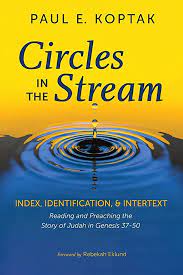Circles in the Stream: Index, Identification, and Intertext

Paul E. Koptak, Circles in the Stream: Index, Identification, and Intertext, Eugene, OR: Wipf & Stock, 2022. 133 pages. $23.00. ISBN: 978-1666735321.
Paul Koptak’s recent book Circles in the Stream is a pleasant introduction to the literary-rhetorical methods of Kenneth Burke and how they can be applied to the interpretation of Scripture. More specifically, Koptak claims that “there are connections within a text that point to the big connection” between the “life issues” in the text and the “life issues that people care about today” (3). In other words, Burke’s literary method ought to be utilized in biblical study for preaching and teaching to help preachers better connect to their listeners in a meaningful and impactful way. In doing so, Scripture remains the central message heard because “the connections are already there… waiting to be found” (3). Burke’s method helps the busy preacher find those connections for the benefit of the listener. Showing that he means to practice what he preaches (so to speak), Koptak applies Burke’s ideas to the story of Judah in Genesis 37-50. While one might feel overwhelmed by Burke’s method at first (particularly if one has never read or even heard of Burke), Koptak is a splendid guide through his ideas and how they help in interpreting Scripture.
Burke’s method contains three primary aspects: index, identification, and intertexts. As mentioned above, Koptak argues that this threefold Burkian method aids preaching tremendously. He defines preaching as “the communication of the Bible text’s message with the purpose of achieving the same rhetorical effect that was intended for the original audience” (34). Employing Burke’s method helps the preacher convey the Bible’s message in a clearer (and potentially more applicable) way as the method is used. A quick look at the three aspects is helpful here.
First, index refers to locating “the works’ structure to uncover… what it is supposed to do for the writer and the reader” (36). This is done by combing the text thoroughly, performing tasks such as identifying key terms, locating words and themes that are seemingly against each other, analyzing the form of the work, and observing where transformation occurs.
Second, identification is defined as “the symbolic overlap of experience in literary art that touches our lives” (56). Koptak sees major points of identification as key in the interpretive process because it is here that we discover “the life issue, the connection that the artful text of Scripture was written to address” (56). To put it a different way, preaching ought to help listeners engage with Scripture in a way that can link them personally to what is seen there. This is done by preaching with an appeal to common experiences and interests and emphasizing how God transforms people and gives them a new identity.
Last, intertext seeks to highlight the related nature of the Old and New Testaments. It does this through a “canonical approach” to Scripture interpretation, which “looks for relations within each testament and explores the relation of the two testaments, recognizing the ways that all texts relate to one another” (96). Such a practice ensures the preacher interprets Scripture in a way that moves beyond merely “a catalogue of historical details or literary artistries” towards theological interpretation that “goes hand in hand with biblical theology,” primarily telling us about God (117).
While interpretive methodology matters much and aids us greatly, Circles in the Stream reminds us that reading (and preaching) Scripture is truly an art. It is particularly an art when we can see Scripture’s deeply interwoven connections like a great painting, linking together the different parts of the whole that bring us to a better understanding of the bigger picture – in this case, God. Literary-rhetorical analysis might not scream “applicable” to all, but Koptak convincingly shows that such a framework allows for the interpreter to see such links in a way that is natural and faithful to the text. Koptak serves as a ready guide in this journey of interpretation, carefully leading us to see how Scripture spreads outwards into our own stories, joining its story with our own. Anyone who desires to read, preach, and sit under Scripture will benefit greatly from this book.
Aaron Weber
ThM Student
Denver Seminary
January 2023
